Custom Design
Brand voice confusion is losing your company more than you know. When your customer service is formal while your social media is conversational, and your website copy is that of a technical guide, potential buyers are having trouble relating to who you actually are. This dissonance doesn’t only confuse your customers—it erodes trust, waters down your message, and gives your competition an edge.
Creating a robust brand voice isn’t about discovering the ideal tone one time and never changing it. It’s about establishing a predictable communications personality that honestly expresses your values, connects with your audience, and sets you apart from others on every single touchpoint.
This in-depth guide will take you through the strategic underpinnings of building voice, teach you how to create genuine voice architecture, put in place systems for uniform expression, and track the effects of your communication approach on brand awareness and customer loyalty.

Brand voice is the personality and emotional tone your company employs to speak with the world. Consider it your company’s communication DNA—the reliable character that shines through whether you write a social media update, reply to customer inquiries, or produce marketing collateral.
Your brand voice includes three key elements that collaborate to build recognition. Brand personality defines the human traits that your company represents—are you professional with a friendly touch, daring and confident, or caring and supportive? Brand tone of voice establishes how you use this personality in a particular choice of words, sentence structure, and way of communicating. Brand voice guidelines are your guide, guaranteeing everyone in your organisation speaks as genuinely as one.
The business effect is immediate and quantifiable. When your customers are consistently hearing voice on your website, emails, social media, and customer support, they start to recognize and trust your brand subconsciously. That recognition is carried over into deeper emotional bonds, more customer loyalty, and cleaner differentiation from competitors who have not spent the effort developing voice.

Your brand voice has a direct impact on the perceptions customers have of your credibility, expertise, and trustworthiness. When you communicate consistently across all touch points, customers gain confidence in your brand’s reliability. It becomes especially valuable when customers are shopping their options around—more likely to select the brand that feels familiar and trustworthy.
Real communication builds emotional connections that influence buying decisions. Customers know when brands are being real or when attempting to be something they don’t really stand for. Your real brand voice is a competitive edge because it’s not possible for competitors to copy your authentic personality and values.
A clearly defined brand voice system enhances operational effectiveness throughout your organisation. Once everyone knows how to speak on your brand’s behalf, content production is quicker, customer service answers sound more integrated, and marketing messages naturally resonate with your overall brand strategy.
Consistent voice deployment eliminates customer confusion and fortifies brand memory. As customers read the same personality in your email newsletters, social media updates, and phone calls, they start correlating that voice with your brand. Such correlation makes your advertising more efficient since customers identify your communication style even before they notice your logo.
Smart voice adaptation enables you to keep personality while optimizing for various platforms and audiences. Your fundamental voice doesn’t change, but you may vary levels of formality, word choice, or content length depending on whether you’re talking through LinkedIn, Instagram, or customer service emails.
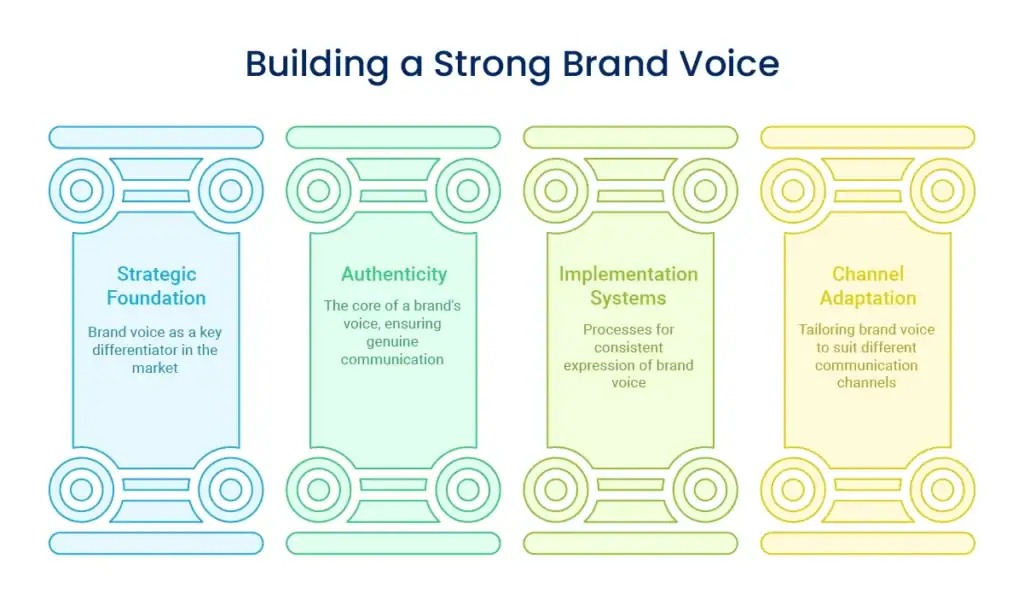
Begin by establishing your brand’s foundational personality characteristics using tangible, specific terms. Instead of describing your brand as “professional,” indicate whether you’re “expert-level professional,” “approachably professional,” or “creatively professional.” These distinctions make it clear to your team exactly how to personify your brand personality in communication.
Your personality foundation should reflect your company values whilst appealing to your target audience’s preferences. If your customers value transparency and honesty, your brand voice should embody these traits through direct communication, acknowledgment of limitations, and genuine enthusiasm about your expertise areas.
Develop a tone palette that depicts how your brand voice responds to various circumstances while staying true to consistent personality. Your celebratory tone can be more energetic and exclamation-mark filled, while your empathetic tone is more understanding and supportive without ever losing your essential personality characteristics.
Plot your tone variations to use them in particular communication situations. Customer complaint replies need empathy and solution language, while promotional copy can be used with greater energy and excitement. Such mapping enables voice adaptation without causing personality confusion.
Create specific language guidelines that embody your brand personality in real-world terms. This encompasses vocabulary preferences (do you say “help” or “assist,” “buy” or “invest,” “customers” or “clients”), sentence structure preferences (brief and punchy vs. detailed and explanatory), and formatting preferences that align with your voice objectives.
Your language structure should also contain words and phrases to steer clear of—words that work against your personality or cause misunderstanding regarding your brand position. If you’re taking the friendly expert stance, stay away from super-futuristic jargon that pushes away your audience or super-informal speak that cheapens your expertise.
Envision how your brand voice elicits certain emotional reactions among your audience. Your message should always be evoking emotions that support your brand objectives—confidence in your know-how, enthusiasm about possibilities, comfort with your dependability, or inspiration from your vision.
Establish emotional coherence by associating your voice selections with intended customer emotions. To make customers feel assured about their choices, your voice must be reassuring and informative. If you want them to feel enthusiastic about prospects, your voice must be energetic and optimistic.
Think about where your brand voice belongs within your industry culture while being distinct enough. Knowing how your industry communicates informs your choice to either go along (keeping credibility) or stand out (making memorable differentiation).
Your voice must resonate with your brand in a way that is also suitable for your business environment. A brand strategy development process that takes industry norms into account, plus your individual personality, produces the strongest voice position.
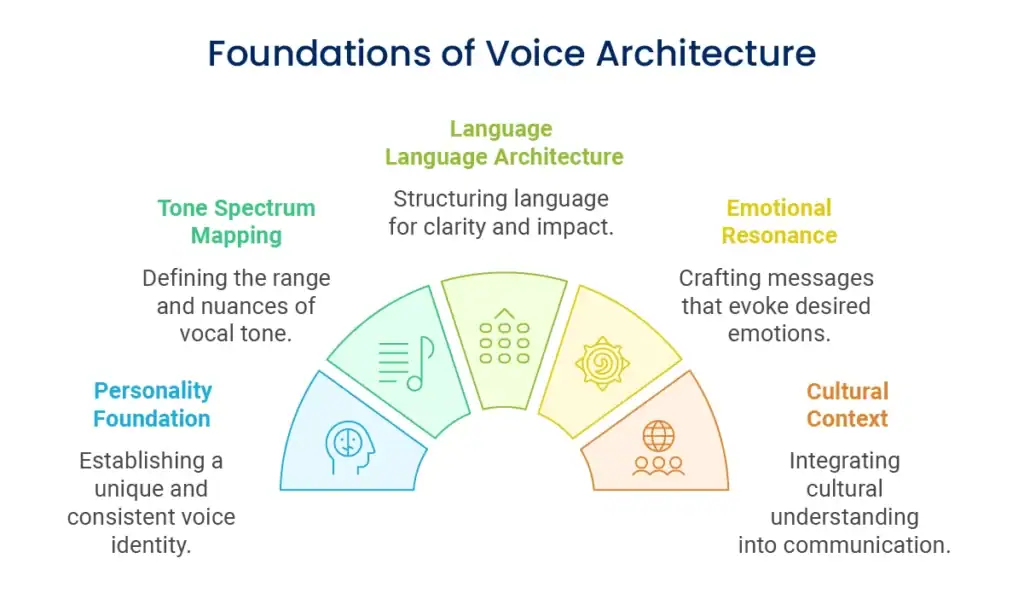
Develop detailed brand voice guidelines that can be followed by any member of your team. Use particular examples of your voice in practice, side-by-side comparisons illustrating your voice and how it compares to other strategies, and straightforward explanations as to why a decision works for your brand personality.
Your guidelines must have actionable templates for typical communication situations. Give examples of social media posts, email replies, website content, and customer service scripts. These templates provide your team with tangible starting points while ensuring voice consistency.
Establish training regimes which enable your team to internalise your brand voice instead of memorising rules. Role-playing, voice practice sessions, and constant feedback assist team members in building instinctive knowledge of your communication personality.
Establish voice mentorship programs where old team members train new team members in implementing voice. The peer-to-peer learning process tends to be more effective compared to formal training since it offers constant support and practice of real-world applications.
Put review processes in place that are voice-consistent without hindering your content creation process. Create rapid voice checklists that allow content authors to self-assess their own work prior to submission, decreasing cycles of revision while upholding standards of quality.
You might include voice spot-checks, whereby senior members of staff quality-check random samples of customer-facing communication to spot voice inconsistency before these develop into patterns. This is a preemptive measure to prevent voice drift over time
Align your voice implementation across every customer touchpoint to deliver cohesive brand experiences. Your website content, social media updates, email marketing, and customer service conversations should sound like they are emanating from the same personality, even when tailored for other purposes.
Create channel-specific voice tweaks that preserve personality while optimizing for platform imperatives. Your LinkedIn content may incorporate more technical terms than your Instagram comments, but they both should express the same brand personality and values.
Construct evolution systems for your brand voice using customer feedback and business expansion. Conducting regular voice audits ensures that you know where your communication is becoming inconsistent or where changes in the marketplace necessitate voice shifts.
Establish customer response feedback loops that track customer reactions to your communication voice. Customer service interactions, social media comments, and the response rate of your emails give you great insights on how well your voice is being received by your market base.
Integrate voice measurement into your normal marketing and communication metrics. Monitor customer engagement rates, response times, and satisfaction scores to learn how voice changes affect business results.
Your performance monitoring should incorporate voice-related indicators that enable you to comprehend the relationship between communication consistency and customer loyalty, brand awareness, and sales performance.
Install technology solutions that promote consistent voice application as your team expands. Content management systems, customer service platforms, and social media scheduling applications ought to have voice guidelines and voice examples that assist team members in staying consistent.
Consider creating voice-checking tools or templates that complement your current workflow systems. These tools can offer real-time feedback regarding voice alignment, ensuring consistency without demanding long manual review processes.
Shift your focus to developing long-term voice equity that builds brand awareness and loyalty over the long haul. Repeated voice application produces compounding value—every interaction with a customer reinforces your personality and deepens the emotional bond between your audience and your brand.
Monitor long-term voice effectiveness measures such as brand recognition surveys, customer retention, and spontaneous brand mention. These metrics allow you to measure how voice consistency builds sustainable business growth and competitive success.
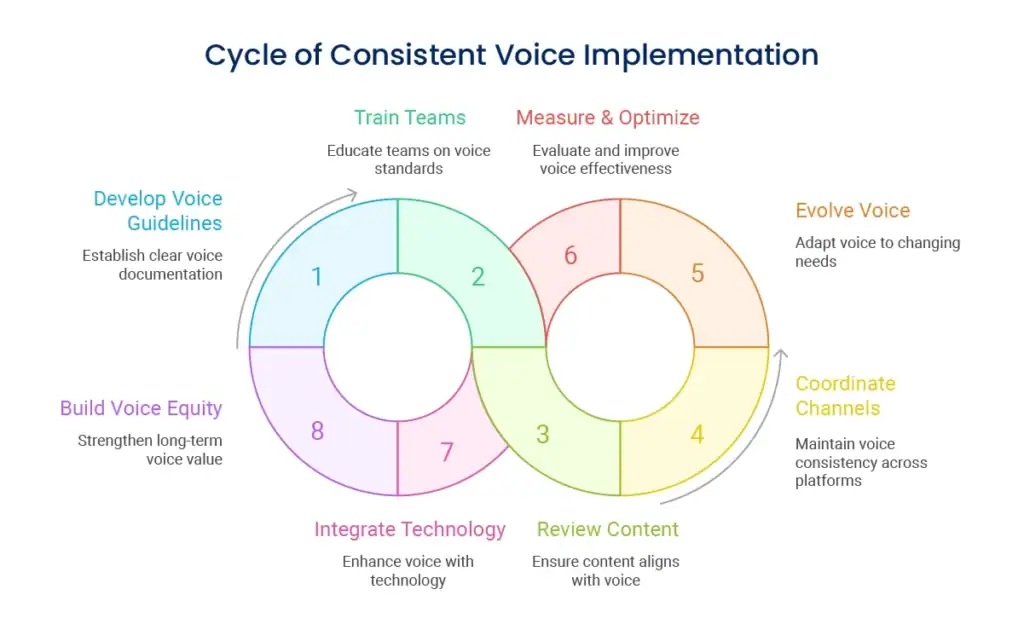
The voice of your website should express your brand personality immediately while engaging visitors in leading to desired behaviors. Home page copy must create personality quickly, service pages must create credibility-based language, and blog posts must prove expertise while keeping communication friendly.
Create page-type specific voice guidelines that ensure personality consistency while optimizing for various user intents. Product pages can prioritize benefit-led language, while about pages permit richer personality-inspired storytelling that fosters emotional connections.
Social media demands voice adaptation that preserves personality while adopting platform-specific communication standards. Your Instagram voice may be more visually descriptive and concise, while LinkedIn content provides room for more in-depth professional analysis, but either should fairly reflect your brand personality.
Develop platform-based voice examples demonstrating how your personality adapts to various social settings. This will help your team comprehend the right levels of adaptation without confusing or contradicting personalities.
Customer service calls are critical voice implementation opportunities that have a direct effect on customer satisfaction and loyalty. Your customer support team must reflect your brand personality while working on resolving problems and taking care of customers.
Create service scenario-specific voice scripts that retain personality while satisfying typical customer requirements. Resolution of complaints, product queries, and general inquiries all need to be approached slightly differently while still reflecting consistent brand personality along the way.
Email marketing voice must sound personal and uniform in its attempt to drive desired behaviors. Your newsletter voice can be conversational and relationship-oriented, while promotional emails need benefit-oriented language to remain personality-driven while instigating purchases.
Develop email-type specific voice rules that assist your team in keeping things consistent in welcome sequences, promotional campaigns, and nurture series. Every email should be personally reflective of your brand while fulfilling its individual role in your customer journey.

Monitor how well your brand voice is recognized by customers through various channels and touchpoints. Voice recognition surveys, brand recall research, and customer feedback analysis indicate how well your voice produces memorable brand experiences.
Monitor voice consistency via frequent checks of your customer-facing content. Random sampling of social media updates, email newsletters, and website content assists in locating areas where voice implementation may be inconsistent or ambiguous.
Track how voice shifts affect customer engagement levels, response rates, and interaction quality. A/B test various voice strategies for particular types of communications to see which voice changes create the most compelling customer response and business results.
Include in your analytics and reporting voice-specific measures that enable you to see the correlation between communication style and customer behavior so you can make data-driven voice optimization choices.
Monitor voice consistency and its correlation with customer satisfaction scores, retention rates, and advocacy behaviours. Those customers who experience consistent and authentic brand voice across touchpoints normally demonstrate higher levels of satisfaction and loyalty.
Survey customers regarding their own perception of your brand personality and communication style. This information assists in understanding whether your perceived voice matches customer perceptions and indicates where voice needs to be refined or clarified.
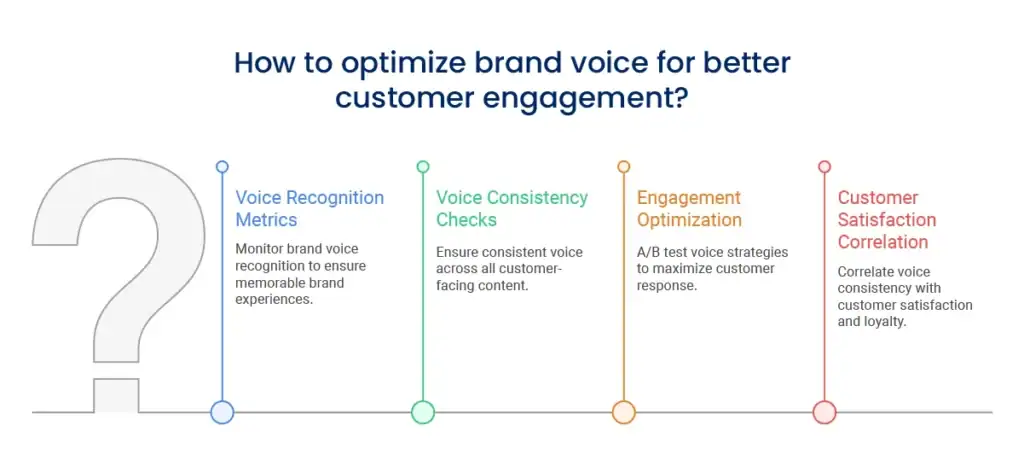
Create organisational systems that enhance voice excellence as your business expands. This encompasses voice alignment-recruiting practices, voice implementation-building training programmes, and leadership modeling of genuine brand messaging.
Develop voice champion programs in which dedicated team members become voice specialists who assist others with implementation and continue to offer voice coaching. Internal experts ensure voice quality is sustained while lightening the leadership load for voice management.
Prioritize voice equity-building that transforms into a long-term competitive strength. Sustained voice usage builds cumulative brand worth that deepens customer relationships, enhances brand awareness, and drives premium pricing initiatives.
Your voice strategy will need to grow with your business while preserving key personality characteristics customers have come to know and trust. This intersection of evolution and consistency needs constant focus but generates significant long-term business value
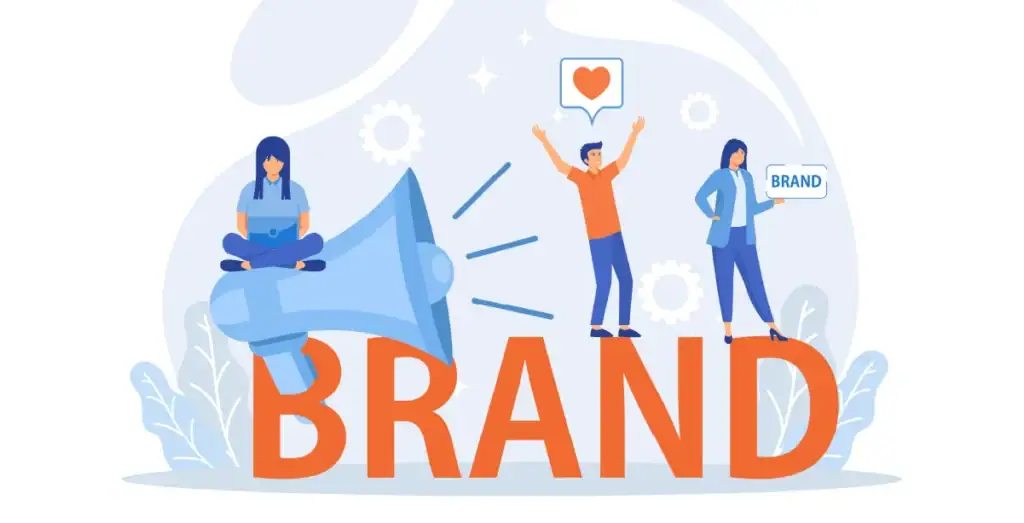
Perhaps the most devastating error is the presentation of different personalities on different channels of communication. When your social media reads playful while your email marketing reads corporate, customers don’t know who you are, eroding trust and brand identity.
Avoid this by developing rich voice guidelines that illustrate the way your consistent personality flexes appropriately across different channels while retaining recognisable core characteristics. Frequent cross-channel voice audits catch inconsistencies before customers are confused.
A few brands change their voice so much for various audiences or contexts that they lose their own identity completely. This design produces communication that sounds generic instead of truly reflective of your brand character and values.
Have a robust personality anchor that is consistent even when varying tone or levels of formality. Your fundamental personality characteristics must be identifiable whether you’re sharing achievements, dealing with issues, or describing intricate information.
Developing thorough voice guidelines without supplying proper training and implementation support tends to result in variable application. Team members might comprehend your voice intellectually but will lack the confidence to apply it effectively in their day-to-day activities.
Use guidelines as a complement to practical training, ongoing feedback, and mentorship programs that allow team members to learn intuitive voice implementation skills. Experience and coaching generally turn out to be more helpful than documentation alone.
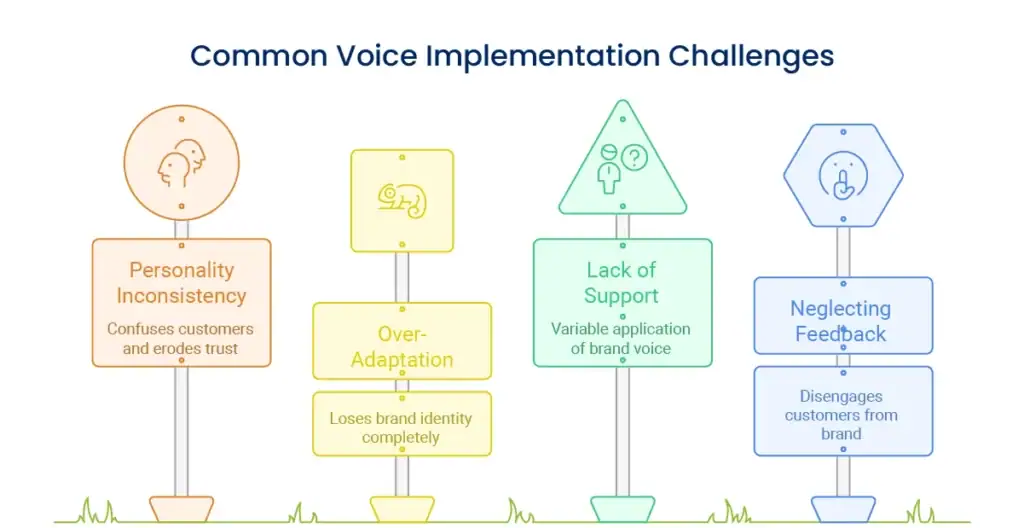
Not tracking customer reactions to your voice options can result in communication that is genuine to your organization but not engaging to your customers. Customer feedback is key to understanding voice success and opportunities for improvement.
Continuously gather and examine customer feedback regarding your communication style, personality, and voice success. This feedback should drive voice optimization decisions while staying true to your authentic brand values.
Effective creative ad production involves systematic testing methodologies that capture high-performing creative elements and maximize total campaign effectiveness. Your testing strategy must distinguish specific creative variables, set definitive success metrics, and produce actionable insights for future creative development.
Creative testing must assess both short-term performance measures and longer-term brand effects measures. Short-term measures such as click-through rates and conversion rates give real-time optimisation information, whereas brand lift studies and message recall tests provide insight into net brand-building effects.
High-performing ad creative comes from ongoing optimization through performance insights and user feedback. Your creative development workflow should include frequent performance evaluation, regular creative refreshes, and strategic shifting in response to market reception and evolving audience taste.
Stats-driven creative iteration calls for combining statistical significance with creative instinct. Your optimisation process should leverage performance data to inform creative choices while preserving the creative risk-taking required for exception campaign performance.
In-depth creative ad analysis goes beyond typical advertising metrics to encompass creative-specific measures of performance that guide future development plans. Your analytics strategy should monitor creative element performance, message resonance metrics, and brand perception shifts due to particular creative strategies.
Analytics for creative performance should bridge short-term campaign metrics and longer-term business results, enabling you to see which creative strategies lead not only to immediate engagement but long-term customer value and business growth.
Brand voice recognition usually builds over 6-12 months of persistent application on all customer touchpoints. Early recognition sets in in the initial months, but core voice association and customer loyalty build via prolonged consistency over time.
The timeline is based on frequency of communication, diversity of channels, and quality of consistency. Brands with greater communication quantity and high-quality consistency generally witness recognition growth more quickly than brands with fewer touchpoints or inconsistent execution.
Your fundamental brand personality must be kept consistent as your company expands, yet voice applications can develop to adapt to greater experience, broader services, or more targeted market positioning. Evolution, not a whole change, is key—customers should still be able to identify your basic personality.
Use voice evolution when going into new markets, entering substantially different services, or when customer response suggests voice changes would better suit your audience while still representing true personality.
Voice consistency with several team members demands extensive guidelines, frequent training, open approval procedures, and continuous feedback mechanisms. Establish voice mentorship programs through which experienced team members mentor others for voice deployment and offer frequent coaching assistance.
Use voice spot-checks and peer review procedures which detect inconsistencies early and create opportunities for learning. Ongoing team voice practice sessions ensure consistency and resolve questions before they affect customer-facing communication.
Brand voice mastery takes strategic planning, diligent application, and continuous refinement, but the bottom-line value justifies the investment. When your genuine personality shines through at every touchpoint, you build emotional connections that generate loyalty, word-of-mouth, and lasting competitive advantage.
Your voice then becomes most effective when it genuinely represents your values and finds resonance with customer wants and desires. This connection leads to trust, differentiation, and recognition that propels sustainable business growth and market position enhancement.
Keep in mind that voice development is a continuous process and not a one-off project. Periodic assessment, incorporation of customer feedback, and employee training guarantee your voice stays effective, real, and in sync with your business objectives as you develop and change.
The companies that invest in voice excellence early and see consistency over time will generally have more customer relationship strength, higher rates of retention, and better marketing across all channels. Your authentic voice is one of your greatest assets in brand positioning.
Creating a genuine, harmonious brand voice that generates awareness and customer loyalty demands strategic planning and systematic execution. If you’re interested in customized advice in creating your voice strategy or deploying voice systems promoting your company growth, our brand communication strategy specialists can assist you in designing voice solutions specifically suited to your unique aims and market status.

Enter your email to get instant access